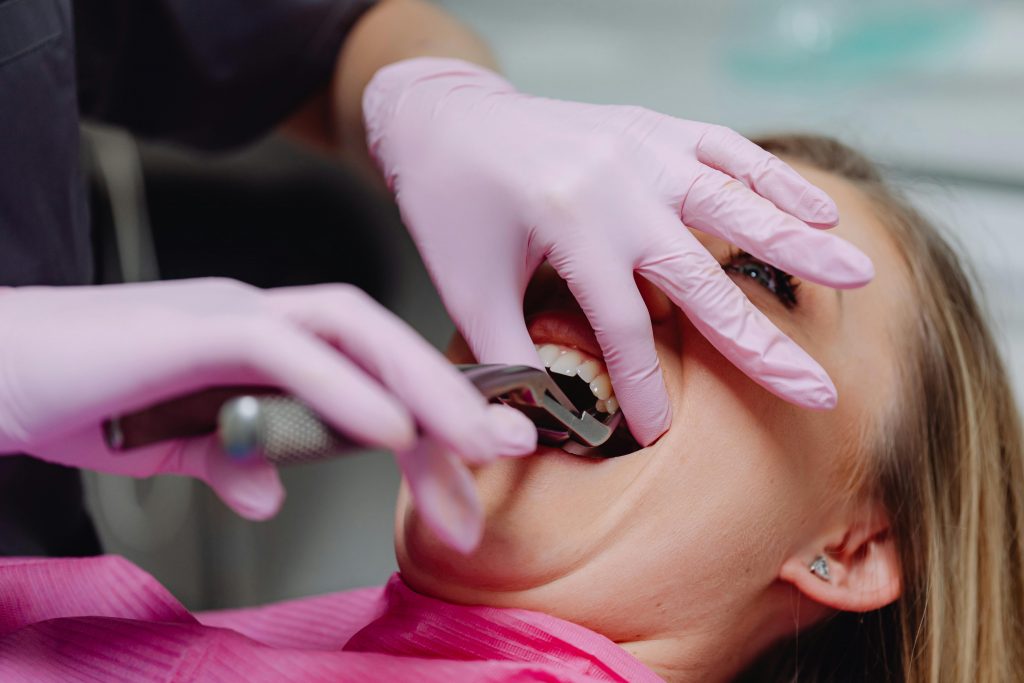
How Long Does a Tooth Extraction Take? A Complete Guide
Disclaimer: The material provided is designed to inform readers about oral health and preventive care. It should not be considered medical advice. Consult a registered dentist for guidance specific to your oral health needs.
Tooth extractions are common dental procedures, whether it’s due to a damaged tooth, overcrowding, or wisdom teeth issues. If your dentist says you need a tooth pulled, it’s normal to wonder: How long does a tooth extraction take?
The answer depends on several factors, such as the type of tooth, its condition, and the complexity of the removal. In this article, we’ll walk you through how long the process takes from start to finish, what to expect during recovery, and how to heal faster by following the right aftercare steps.
What Happens Before the Tooth Extraction?

Before the procedure begins, your dentist will do a full exam of your mouth, which may include taking X-rays. This helps them see the position of your tooth and its roots. You’ll also be asked about your medical history and any medications you take.
Next comes anesthesia. Your dentist will numb the area around the tooth to make sure you don’t feel pain. For more complex extractions (like impacted wisdom teeth), they may use sedation or general anesthesia.
How Long Does the Extraction Take?
The length of time it takes for a tooth extraction depends on the complexity of the procedure. A simple extraction typically lasts between 20 to 40 minutes, while more complex cases, like removing impacted teeth or those requiring surgical intervention, can take between 45 minutes and 90 minutes or longer. Factors like the tooth’s position, its condition, and whether additional steps are needed can impact the duration of the extraction.
Simple Extraction
A simple extraction is performed when the tooth is visible and easily accessible, often due to damage or decay. This procedure typically lasts 20 to 30 minutes. The dentist numbs the area with a local anesthetic, then loosens and removes the tooth using an elevator and forceps. Since the procedure is straightforward, most patients experience minimal discomfort and quick recovery. Aftercare is important to avoid complications, but most people return to normal activities within a few days, though the socket may continue to heal over the following weeks.
Surgical Extraction
A surgical extraction is needed for teeth that are impacted, broken, or otherwise difficult to access, like many wisdom teeth. This procedure may require cutting into the gum and removing some bone around the tooth. Surgical extractions generally take 45 minutes to over an hour, depending on the complexity. Dentists may use stronger sedation or general anesthesia to ensure comfort. Recovery can take longer than with a simple extraction, often requiring follow-up visits to monitor healing and ensure no complications, such as infection or dry socket, arise. Full recovery may take a few weeks, depending on the complexity of the procedure.
What Happens During the Procedure?

Understanding what happens during a tooth extraction can help reduce anxiety and prepare you for the process. The procedure is typically straightforward and designed to minimize discomfort. Here’s a step-by-step breakdown of the typical tooth extraction process:
Numbing the Area
Before any work is done, the dentist will first numb the area around the tooth. This is done by injecting a local anesthetic, which ensures that you won’t feel pain during the extraction. You may feel a small pinch or pressure from the needle, but the numbing effect will kick in quickly, and the area around your tooth will become completely numb. The dentist may also use a topical gel to numb the gums before the injection, making the process even more comfortable. For patients who are especially anxious or need more extensive work, sedation may also be offered to help them relax.
Loosening the Tooth
Once the area is numbed, the dentist will begin loosening the tooth from its socket. To do this, they use a specialized tool called an elevator, which is designed to gently rock the tooth back and forth. This process is necessary to loosen the tooth without damaging the surrounding tissue or bone. The elevator essentially acts as a lever, creating space between the tooth and the jawbone, which makes it easier to remove the tooth. You may feel some pressure or a sense of movement, but it should not be painful due to the numbing medication.
Removing the Tooth
After the tooth has been sufficiently loosened, the dentist will use a pair of forceps to grip the tooth. The forceps are a special type of dental tool designed for grasping and pulling teeth. The dentist will carefully rock the tooth back and forth, applying gradual force to pull the tooth out of its socket. Depending on the tooth’s position and how well it’s loosened, the extraction may take a few minutes. You may feel pressure during this part of the procedure, but it should not be painful. If the tooth is difficult to remove or is broken, the dentist may need to take extra steps, such as cutting the tooth into smaller pieces to facilitate removal.
Closing the Site
Once the tooth is removed, the dentist will inspect the socket for any remaining pieces of tooth or debris. If necessary, the dentist may need to suture or stitch the gums to close the area. This is more common for surgical extractions, where the gum and sometimes bone are cut to access the tooth. Stitches help the tissue heal properly and protect the area from infection. The stitches used are often dissolvable, meaning they’ll naturally dissolve on their own over a few days to weeks. If non-dissolvable stitches are used, your dentist will schedule a follow-up appointment to remove them.
Gauze Placement
After the tooth is removed and the site is closed, the dentist will place a gauze pad over the extraction site. The gauze helps to control bleeding and encourages the blood to clot in the socket. You’ll be asked to bite down gently on the gauze to apply pressure, which helps stop the bleeding. The dentist will explain how long you should keep the gauze in place—usually for about 30 to 45 minutes. After that, you can remove it, but if the bleeding persists, you may need to replace the gauze with a new one. It’s important to follow the dentist’s instructions on bleeding control and what to expect in the days following the extraction.
What Happens After the Extraction?
After the procedure, you’ll need some time to rest and begin the healing process. You may feel numb for a few hours. Once the anesthesia wears off, you might experience some pain and swelling. This is normal and can be managed with pain medications, either prescribed or over-the-counter.
How Long Does Healing Take?
Most people recover from a tooth extraction in 3 to 7 days, but complete healing of the socket can take 3 to 4 weeks. Here’s what the typical healing timeline looks like:
- First 24 hours: A blood clot forms to protect the socket.
- Days 2–3: Swelling peaks and then starts to reduce.
- Days 4–7: Pain lessens, and the site begins to close.
- Week 2 and beyond: New tissue grows to fill the socket.
Things to Avoid After Tooth Extraction
Following proper aftercare is key to preventing complications like infection or dry socket. Here are the things to avoid after tooth extraction:
- Smoking: Can slow healing and cause dry socket.
- Drinking through a straw: Can dislodge the blood clot.
- Hard, sticky, or hot foods: Can irritate or harm the socket.
- Forceful rinsing or spitting: May wash away the clot.
- Strenuous activity: Increases bleeding and delays healing.
- Touching the site: Increases risk of infection.
- Skipping medication: Makes pain harder to control.
- Alcohol: Interferes with healing and medications.
Each of these things can delay your recovery or cause painful side effects. Follow your dentist’s instructions carefully to heal quickly and avoid setbacks.
What to Eat After Tooth Extraction
Choosing the right foods can make a big difference in your recovery. Stick to soft, cool, and easy-to-chew foods, especially in the first few days.
- Mashed potatoes
- Yogurt
- Applesauce
- Smoothies (without a straw)
- Scrambled eggs
- Oatmeal (cooled)
- Soup (lukewarm)
Avoid spicy, crunchy, or acidic foods that could irritate the socket. As your mouth heals, you can slowly return to your regular diet.
When to Call the Dentist
While most extractions heal without problems, it’s important to watch for warning signs of complications. Call your dentist if you experience:
- Severe or increasing pain after 3 days
- Bad breath or foul taste in your mouth
- Pus or discharge from the extraction site
- Swelling that worsens instead of getting better
- Fever or chills
These symptoms could point to an infection or dry socket and need quick attention.
How to Speed Up Healing
You can help your body heal faster by:
- Getting plenty of rest
- Drinking lots of water
- Avoiding anything that could disturb the extraction site
- Eating healthy, healing-friendly foods
- Following your dentist’s instructions exactly
Some people try natural remedies like warm salt water rinses or cold compresses to help reduce swelling and pain. These can be helpful if used properly and with your dentist’s guidance.
How Soon Can You Go Back to Normal Activities?
After a tooth extraction, it’s important to listen to your body and give yourself time to heal. While most people feel well enough to return to normal activities within 1 to 2 days, it’s important to take it easy during the first few days to avoid complications and ensure proper recovery. The amount of time you need to rest largely depends on how you feel post-surgery and the type of extraction you had. For example, if the extraction was simple and you’re feeling good, you might be able to resume work or school fairly quickly. However, if the procedure was more complex or you’re experiencing discomfort, it’s a good idea to give yourself a bit more time to rest and recover.
Returning to School or Work
For most individuals, returning to school or work within 1 to 2 days is typically fine, as long as they feel up to it. If your job or school schedule doesn’t involve intense physical activity or heavy lifting, and you’re not feeling much pain, you can likely continue with regular tasks. However, if you are dealing with a lot of swelling, pain, or discomfort, it might be better to take an additional day or two off to rest. In some cases, patients may experience difficulty with speaking or eating, which could make it harder to carry out normal work or school duties. For those who don’t have a physically demanding job or school schedule, the focus should be on managing pain and staying hydrated during the first few days.
What About Physical Labor or Activities That Require Talking?
If your job or daily activities involve physical labor, heavy lifting, or strenuous exercise, you should plan to take more time off. Intense physical activity can increase blood pressure, which might lead to bleeding from the extraction site or disrupt the healing process. It’s generally advised to wait at least 48–72 hours before returning to activities that involve lifting, exercising, or vigorous physical movement.
Additionally, if your work requires a lot of speaking, such as in teaching, customer service, or public speaking, you might find it difficult to talk without discomfort in the first few days. This can be especially true if your extraction site is sore or swollen. You may need to plan for reduced talking or even use a voice-saving strategy until the pain and swelling go down. In these cases, it’s worth taking a few extra days off to ensure you’re healing well and to avoid any strain on your mouth. Resting and allowing the site to heal will help prevent complications such as dry socket or prolonged swelling.
Ultimately, returning to normal activities after a tooth extraction is a gradual process. Listening to your body and giving yourself adequate rest time will ensure a smoother recovery and lower the risk of setbacks. If you have any concerns or are unsure whether you’re ready to resume certain activities, it’s always best to consult with your dentist.
Tooth Extraction for Kids or Teens
If your child needs a tooth removed, the process is usually quicker and easier than in adults, but aftercare is just as important. Make sure they:
- Don’t suck on the wound
- Eat soft foods
- Avoid sugary snacks that can irritate the site
- Follow all post-extraction instructions
Always talk to the pediatric dentist if you have questions about your child’s recovery.
Final Thoughts
So, how long does a tooth extraction take? The actual procedure may last anywhere from 20 minutes to over an hour, depending on the complexity. Recovery can take a few days to several weeks.
The most important part of the process happens after the tooth is out. Following your dentist’s instructions and knowing the things to avoid after tooth extraction will help you heal faster and avoid painful issues like dry socket.
Tooth extractions may sound intimidating, but with proper care and a little patience, you’ll be back to feeling like yourself in no time.


